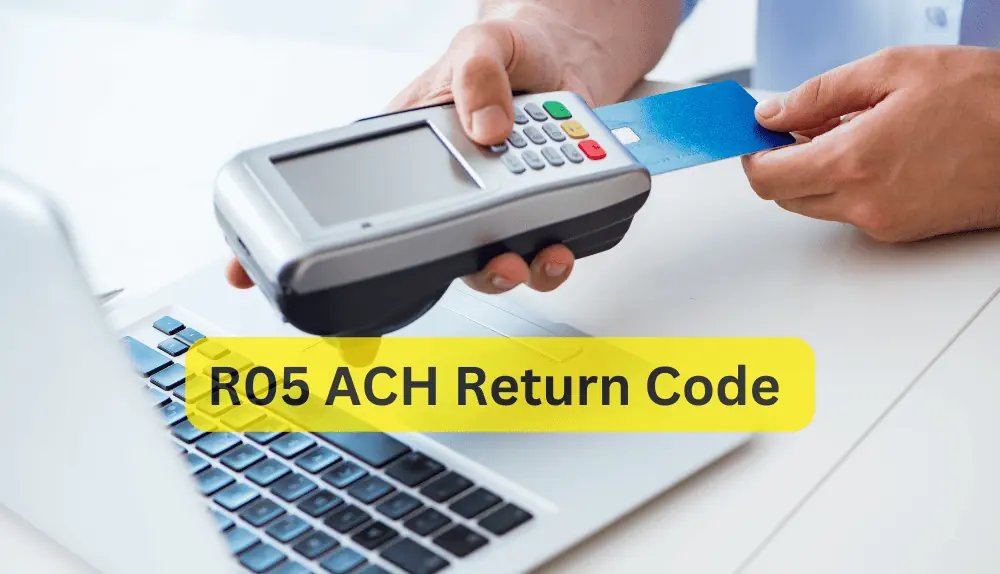The ACH (Automated Clearing House) system serves as the backbone of the modern money movement. However, amidst this digital financial system, a less frequent but important issue is R05 ACH Return Code – Unauthorized Debit to Consumer. This article will help you understand the R05 return code, and explain the causes, and consequences.
What Does R05 ACH Return Code Mean?

The ACH R05 return code, commonly known as “Unauthorized Debit to Consumer,” is a critical notification within the Automated Clearing House (ACH) system that denotes an unsuccessful transaction due to the recipient’s rejection of a debit entry. When this code appears, it indicates that the consumer, the account holder on the receiving end of the ACH transaction, has disputed the payment and asserted that they did not authorize the deduction from their account.
The R05 return code acts as a protective measure for consumers, ensuring that they have the right to dispute any unauthorized debits made to their bank accounts. It places the onus on the originating financial institution to verify and validate the legitimacy of the transaction. Consequently, the receiving bank, acting on behalf of the consumer, returns the unauthorized ACH debit to the initiating institution using the R05 code.
Several reasons may lead to the issuance of an R05 return code, including clerical errors, fraudulent activities, or misunderstandings between the parties involved in the transaction. Regardless of the cause, the ACH R05 return code serves as a crucial safeguard, providing consumers with peace of mind and financial protection in the rapidly evolving landscape of electronic payments.
It is essential for both consumers and businesses to be aware of the implications of an R05 return code. For consumers, vigilance in monitoring their bank accounts can help identify unauthorized transactions promptly, allowing them to report and resolve such issues with their bank. On the other hand, businesses need to exercise diligence in obtaining proper authorization for ACH debits to prevent potential disputes and ensure compliance with ACH rules and regulations. Understanding the significance of the ACH R05 return code is a key step toward fostering trust and confidence in the electronic payment ecosystem.
Reasons R05 ACH Return Code Can Occur
Unauthorized Transactions
One of the primary reasons for the ACH R05 return code is unauthorized transactions. In some cases, consumers may find unfamiliar or suspicious debits in their bank accounts, indicating potential fraudulent activities. Unauthorized access to a consumer’s account could result from compromised account information, phishing scams, or data breaches. When consumers identify such unauthorized debits, they rightfully invoke the R05 return code to protect their finances and trigger an investigation into the transaction’s legitimacy.
Incorrect Transaction Amount
Another common cause for the ACH R05 return code is when the transaction amount differs from what the consumer expected or authorized. Clerical errors or technical glitches during the transaction initiation process can lead to the wrong amount being debited. If the discrepancy is significant, the consumer may reject the transaction and trigger an R05 return code to rectify the error and obtain the correct amount.
Transaction Not Authorized by Consumer
Sometimes, consumers may have given consent for one-time transactions but did not provide permission for recurring or subsequent debits. If a business or entity attempts to initiate further debits without proper authorization, the consumer can rightfully invoke the ACH R05 return code to stop unauthorized future transactions.
Closed or Frozen Accounts
ACH transactions can also face an R05 return code when they are attempted on closed, dormant, or frozen accounts. If a consumer has closed their bank account, the ACH transaction will fail, and the receiving bank will send the R05 return code to the originating bank, indicating the closure of the account.
Insufficient Funds
The lack of sufficient funds in the consumer’s account is another reason for the ACH R05 return code. If the consumer’s account balance is insufficient to cover the debit amount, the transaction will be declined, and the R05 return code will be used to inform the originating bank of the unsuccessful transaction.
Overall, the ACH R05 return code serves as a crucial mechanism to protect consumers from unauthorized and erroneous ACH debits. By understanding the reasons for its occurrence, businesses can take appropriate measures to prevent ACH disputes and ensure compliance with ACH rules, while consumers can remain vigilant and promptly report any irregularities in their bank accounts.
Steps to Fix R05 ACH Return Code
Fixing the ACH R05 return code requires a coordinated effort between the consumer, the receiving bank, and the originating financial institution. Here are the steps to resolve the issue and address the reasons for the R05 return code:

Review Transaction Details
As a consumer, carefully review your bank statement and transaction details to understand the nature of the ACH debit in question. Confirm whether the transaction was indeed unauthorized, if the amount is incorrect, or if there are any other discrepancies.
Contact Your Bank
If you identify an unauthorized or erroneous ACH debit, contact your bank immediately. Inform them about the specific transaction and state that you did not authorize it or that there is an error in the amount. Request them to initiate the ACH R05 return code to reverse the debit.
File a Dispute
Your bank will guide you through the process of filing a dispute related to the unauthorized ACH debit. Be prepared to provide any relevant information or documentation that can support your claim, such as evidence of previous authorizations or account closures.
Secure Your Account
While resolving the issue, it is essential to protect your account from further unauthorized transactions. Work with your bank to review security measures and consider changing your account credentials, such as passwords or PINs, to prevent future unauthorized access.
Coordinate with the Originating Bank
The receiving bank will return the unauthorized ACH debit to the originating financial institution using the R05 return code. The originating bank will receive notification of the return and may reach out to you or your bank for verification. Cooperate with both banks to ensure a smooth resolution.
Verify and Correct Information
For businesses or entities initiating ACH debits, it is crucial to verify the accuracy and validity of the information provided by consumers. Ensure that all necessary authorizations are obtained and accurately recorded. Rectify any errors in transaction amounts or other details to avoid future R05 return codes.
Monitor Your Account
After the dispute has been resolved, continue monitoring your account for any further unauthorized transactions or suspicious activities. Promptly report any anomalies to your bank to prevent potential future issues.
By following these steps and staying proactive, you can efficiently resolve the ACH R05 return code and safeguard your finances from unauthorized ACH debits. Effective communication with your bank and the originating institution is key to ensuring a timely and satisfactory resolution to the issue.
How Can Businesses Deal with ACH R05 Return Code
Dealing with the ACH R05 return code can be a challenging situation for businesses. However, by adopting proactive measures and ensuring compliance with ACH rules, businesses can effectively address and prevent ACH R05 return codes. Here are some steps businesses can take to deal with the ACH R05 return code:
Obtain Proper Authorization
Businesses must ensure they have obtained proper authorization from consumers before initiating any ACH debit transactions. This includes obtaining explicit consent for both one-time and recurring transactions. Keeping accurate records of authorizations is crucial to address any potential disputes related to unauthorized transactions.
Communicate Clearly with Customers
Provide clear and transparent communication to customers about the nature of the ACH transactions and the frequency of debits. Clear communication helps avoid confusion and potential disputes. Offering easily accessible customer support channels allows customers to inquire about transactions if they have any concerns.
Implement Strong Security Measures
Protect customer information and account credentials by implementing robust security measures. This includes secure data storage, encryption, and regular security audits. By safeguarding customer data, businesses can reduce the risk of data breaches and unauthorized access that may lead to ACH R05 return codes.
Monitor Transactions Regularly
Businesses should regularly monitor ACH transactions to identify any rejected payments and ACH R05 return codes promptly. Timely detection enables businesses to investigate and address issues before they escalate, minimizing customer dissatisfaction and potential financial losses.
Respond Promptly to Disputes
If a business receives an ACH R05 return code due to a dispute from a customer, they should respond promptly. Investigate the dispute, verify authorization, and provide a well-documented response to the receiving bank. Open and transparent communication with the customer can help resolve the issue amicably.
Rectify Errors Immediately
If an error is identified in a transaction, whether it’s the amount or the timing, rectify it immediately. Communicate with the customer and the receiving bank to correct the issue promptly. Timely resolutions help maintain trust and a positive reputation with customers.
Stay Informed about ACH Rules and Regulations
It is essential for businesses to stay informed about the latest ACH rules and regulations. Compliance with ACH guidelines ensures that businesses are operating within the legal framework and reduces the risk of ACH R05 return codes due to non-compliance.
Work with Your Bank
Establish a good working relationship with your bank and keep them informed about your ACH practices. They can provide guidance and support in dealing with ACH R05 return codes and help implement best practices for preventing future occurrences.
By following these steps, businesses can effectively manage ACH R05 return codes, minimize disputes, and maintain a reliable ACH transaction process that benefits both the business and its customers.
Final Words
In conclusion, the ACH R05 return code serves as a vital safeguard in the realm of electronic payments, protecting consumers from unauthorized and erroneous ACH debits. Understanding the reasons behind its occurrence empowers both consumers and businesses to take proactive measures and ensure compliance with ACH rules and regulations. For consumers, vigilance in monitoring bank accounts and promptly reporting any irregularities is key to safeguarding their finances.
Meanwhile, businesses must obtain proper authorizations, implement strong security measures, and respond promptly to disputes to prevent ACH R05 return codes and maintain trust with their customers. With a collective effort from all stakeholders involved, the ACH system can continue to facilitate seamless and secure financial transactions in the digital era.
Frequently Asked Questions (FAQs)
How can consumers protect themselves from unauthorized ACH debits and the ACH R05 return code?
Consumers can protect themselves by regularly monitoring their bank accounts for any unfamiliar or suspicious transactions. If they notice unauthorized debits, they should immediately contact their bank, file a dispute, and invoke the ACH R05 return code if necessary.
How can businesses prevent ACH R05 return codes?
To prevent ACH R05 return codes, businesses should ensure they have proper authorization from consumers before initiating ACH debits. Clear communication with customers about the nature and frequency of transactions is essential. Implementing strong security measures to protect customer data and regularly monitoring transactions can also help prevent ACH R05 return codes.
What should businesses do if they receive an ACH R05 return code from a customer's bank?
If a business receives an ACH R05 return code due to a customer dispute, it should promptly investigate the issue and verify the transaction's legitimacy. Open and transparent communication with the customer and the receiving bank is crucial in resolving disputes amicably.
Are ACH R05 return codes reversible?
Yes, ACH R05 return codes are reversible if the issue that triggered the code is addressed and resolved. Once the cause of the return code is rectified, the transaction can be re-initiated successfully.
Can consumers request the ACH R05 return code for any unauthorized debit from their account?
Yes, consumers have the right to request the ACH R05 return code for any unauthorized debit from their account. The ACH R05 return code provides them with a mechanism to dispute and potentially reverse unauthorized ACH debits.

